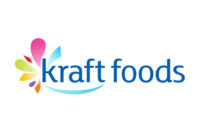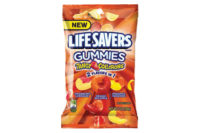Wrigley to Buy Altoids and Life Savers From Kraft
![]()
Wrigley to Buy Altoids and Life Savers From Kraft
By Elizabeth Fuhrman
Chicago-based Wm. Wrigley
Jr. Co. agreed to purchase a group of candy brands, including LifeSavers
and Altoids, from Northfield, Ill.-based Kraft Foods for $1.48 billion. The
agreement also includes ownership of the Crème Savers brand, as well
as Trolli gummy candies, Sugus candies and other local and regional brands
in the United States, Europe, Indonesia and Thailand. The sale unloads
brands that generated roughly $500 million in sales for Kraft.
The sale comes as part of Kraft Chief Executive Roger
Deromedi’s effort to trim down the company’s portfolio and
focus on increasing the sales of its core brands. Kraft, with $31 billion
in sales, decided to relinquish most of its confection brands in order to
concentrate its sales force on markets in which it was dominant.
The deal will also help satisfy Wrigley’s
appetite for a major acquisition. In 2002, Wrigley had an agreement with
Hershey Foods Corp. to purchase the chocolate maker for $12.5 billion, but
the deal fell apart at the last minute when Hershey’s controlling
trust voted against it.
“There are only a handful of confectionery
brands around the world that have the combination of heritage and vitality
that can match up with Wrigley brands,” said Bill Wrigley Jr., the
company’s chairman, president and CEO. “Altoids and Life Savers
are two such brands.”
The purchase comes after a competition that pitted
rivals Hershey, Mars Inc., Nestlé SA and Cadbury Schweppes PLC
against Wrigley, which delivered a larger dollar figure than industry
analysts expected.
Wrigley said the all-cash purchase price would be
partially offset by about $300 million in cash tax benefits associated with
the amortization of intangible assets. The net acquisition cost of $1.8
billion represents 2.4 times estimated 2004 sales. The transaction is
expected to be completed by mid-2005.
Altoids reinvented the mint category about a decade
ago with its quirky advertising and tins, which helped double the average
amount of money that people spent on mints. According to ACNielsen figures,
Altoids sales have grown 14 percent in the past four years.
LifeSavers, which have
been around since 1912, saw sales decline about 16 percent in retail
dollars over the past four years, according to ACNielsen.
Wrigley, along with Hershey, Masterfoods and
Nestlé, dominates in the checkout aisles of grocery and convenience
stores, a strength Kraft lacked with its confectionery brands. Wrigley,
one-tenth of Kraft’s size, has about 7.8 percent of the U.S.
confectionery market, according to Wall Street Journal analysts. Kraft had
about 4.7 percent.
When Georgia Nut Co., Skokie, Ill., inked the deal to
acquire Atlanta-based Sophie Mae Candies in September, the move provided a
new lease on life for the 86-year-old peanut brittle maker.
Once a family-owned concern, Sophie Mae had most
recently been owned by Gilliam Candy of Paducah, Ky. In addition to Sophie
Mae peanut brittle, the company’s stable of brand names also includes
Slo Poke, Kits, BB Bats and Black Cow, all of which Georgia Nut acquired in
the transaction.
Michael Dougherty, vice president of sales and
marketing for Georgia Nut Co., expects the acquisition to open some new
doors for the company.
Currently Georgia Nut Co.’s business is split
into three areas. The company operates an ingredient supply business; sells
branded and bulk candy and nuts under the Georgia label; and serves as a
contract manufacturer.
All three areas are important to Georgia Nut going
forward, says Dougherty. “I think we have the opportunity to continue
to grow the industrial ingredients and contract manufacturing business, but
they are more volatile than the branded business. We have the ability to
control our fate a little more if we can expand the amount of our business
that is under the branded names.”
To that end, the strong Sophie Mae peanut brittle
brand (retail customers include Walgreen’s), provides a good point of
entry for Georgia Nut’s stable of brands—both those it
currently sells as well as those the company hopes to add in the future.
“Being the vendor of record in an account opens
up the door to have a discussion about the other brands under your
umbrella,” Dougherty reflects. “It’s an opportunity to
grow the depth of our distribution.”
Dougherty sees a particular opportunity to court
nostalgia-loving consumers by expanding Georgia Nut’s stable of
nostalgic confections. “Our strategy is two-fold,” he reflects.
“First, we will promote the nostalgia candy brands by ourselves, as
well as look toward other nostalgia candy brands and companies to form
partnerships. Secondly, we will look for line extensions utilizing the
existing brand names that we acquired.
“We view the Sophie Mae acquisition as a first
step in growing the branded business,” he continues.
“Ultimately, what we’d like to do is to move forward having
five or six $5 million-plus brands in our portfolio.”
—Mary Ellen Kuhn
Hershey’s new senior sales executive Christopher
J. Baldwin has been on the job for only a few weeks, but his priorities are
crystal clear.
Baldwin is committed to ensuring that Hershey
continues to focus its sales resources on the retailers that are doing the
best job of meeting consumers’ needs. During the course of an
interview in Hershey, Pa., earlier this month, Baldwin emphasized the
importance of ensuring that Hershey’s sales organization is
“focused on winning with the right customers.
“Fundamentally, what I do is make sure that we
have the right resources focused against the right customers at the right
time,” says Baldwin. “The ongoing allocation of resources is my
primary responsibility.”
Who exactly are the “right customers?”
According to Baldwin, they’re the retailers that are doing the best
job of delivering value and convenience to the consumer.
It’s no coincidence then that the channels in
which Hershey is scoring some of its biggest successes include warehouse
club stores, mass merchandisers, convenience stores and dollar stores.
“The places where we’re winning are the
channels where the underlying strategy includes a focus on value and/or
convenience,” Baldwin reflects. “Consumers are increasingly
moving their dollars to those channels.”
Baldwin counts Hershey’s limited edition offerings as
key contributors to the company’s strong sales performance.
“We have great opportunities in our core
confections business, and we also have opportunities in some of the
adjacencies that we have entered into, including Mauna Loa, a recent
acquisition that will continue to accelerate our snacking growth,”
says Baldwin.
Hershey announced in November that it had entered into
an agreement to acquire Mauna Loa Macadamia Nut Corp. from The Shansby
Group, a private equity investment firm. Mauna Loa, based in Hilo, Hawaii,
is the nation’s leading processor and marketer of macadamia nuts,
with annual sales of approximately $80 million.
Before coming to Hershey, Baldwin was national vice
president, field sales and logistics at Kraft Foods. His title at Hershey
is senior vice president, global chief customer officer. His professional
background includes leadership roles in sales and logistics within
Kraft’s Nabisco operation.
Hershey announced Baldwin’s appointment this
fall along with a series of other changes to the Hershey executive team.
The changes include the retirement, effective Dec. 31, 2005, of Frank
Cerminara, senior vice president, chief financial officer. Succeeding
Cerminara will be David J. West, who is currently senior vice president,
chief customer officer.
West begins his new role as CFO on Jan. 1, 2005.
—Mary Ellen Kuhn
Looking for a reprint of this article?
From high-res PDFs to custom plaques, order your copy today!








